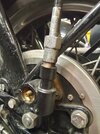I heard that Canadian gauntlet hit the ground with a 'thump' before I even looked at this, ahem, thread. OK, fellah, I'll see your tap, and raise you a traveling microscope.they do fit much better in the 26 tpi than the 1mm pitch.
The first photograph is a top-down view of the microscope, showing it has a precision-ground thread that moves the microscope objective sideways, with 1 mm divisions on the scale at the top, and 0.01 mm for the finest divisions on the rotary dial, so by interpolating between those it allows readings to be made to an accuracy of ~2 µm.
The reason I decided to use this is some years ago I tried quite hard, but unsuccessfully, to find if there was a precision standard for pitch gauges. That is, if a pitch gauge is marked '26', does that mean it is an accurate 26.0 (or 26.00, or…) tpi, or could it be, say, 26.13? Or even as far off as 25.49? The answer is, we don't know. Or, rather, I don't know, and I couldn't find any reputable source that does know. Anyway, I carefully aligned my speedometer thread horizontally and along the axis of the crosshair in the eyepiece to eliminate any sine errors. The next photograph, taken before I had spent the time to align it, shows the view through the eyepiece.
I avoided the first and last threads, carefully set the microscope on the crest near one end, recorded the position to the nearest ~2 µm, then moved the microscope through 10 turns and recorded that position. The difference, divided by 10, gives the pitch.
So, what did I find? Was the pitch 1.000 mm (25.400 tpi), or was it 26.000 tpi? The answer is, neither. Averaging several measurements of both the peaks and troughs, the average pitch over a length of 10 threads is 26.44 tpi.
How can this be? First, the difference is small enough, and the tolerances large enough, that the relatively few threads engaged by a nut of exactly 26.0 tpi wouldn't bind. Could the .44/26.44 = 1.7% increase in length that would result in that change in pitch be due to long-term change in dimension of this zinc-based casting? Modern references claim current materials have "excellent" dimensional stability, but I haven't looked into what that word means in practice, nor how the alloys cast 70 years ago behaved.

